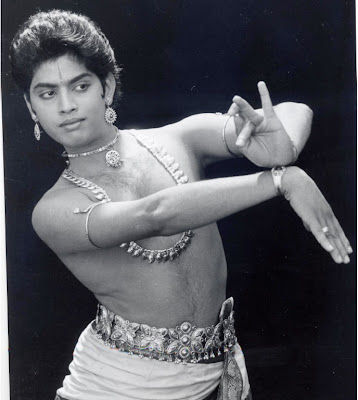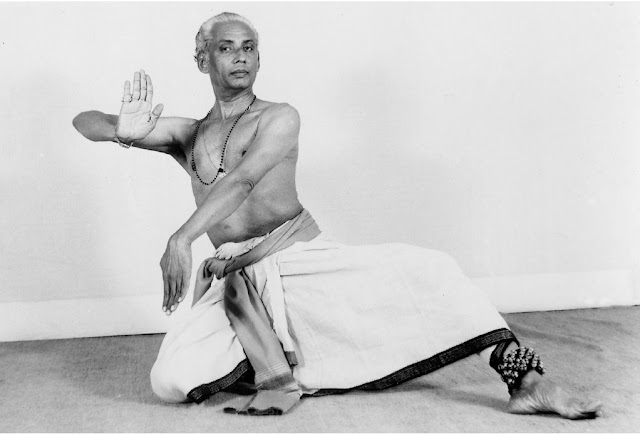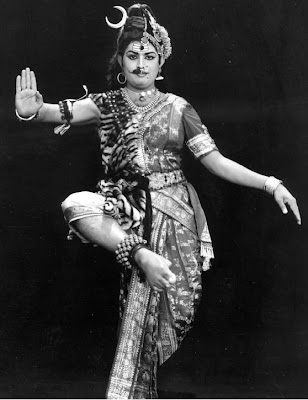 An adolescent boy walked quietly down a narrow darkened path in between two thatched huts in the early hours of the morning prior to sunrise. He moved softly over to the larger of the two huts and peered through a small opening in the wall, which had been borne through by rodents that inhabited the area. Inside, the great master was at work, lost in concentration while choreographing a new item. Two senior students stood before the master, ready to enact the next movement he fashioned from his mind. Outside, the boy remained motionless, afraid of the consequences if he disturbed the master during these early morning choreography sessions. For the next three hours, he watched in silence, peering through the opening in the wall until that day’s choreography was complete. The master was none other than the legendary Kuchipudi guru Vempati Chinna Satyam, and the boy was none other than his son, Ravi Shankar.
An adolescent boy walked quietly down a narrow darkened path in between two thatched huts in the early hours of the morning prior to sunrise. He moved softly over to the larger of the two huts and peered through a small opening in the wall, which had been borne through by rodents that inhabited the area. Inside, the great master was at work, lost in concentration while choreographing a new item. Two senior students stood before the master, ready to enact the next movement he fashioned from his mind. Outside, the boy remained motionless, afraid of the consequences if he disturbed the master during these early morning choreography sessions. For the next three hours, he watched in silence, peering through the opening in the wall until that day’s choreography was complete. The master was none other than the legendary Kuchipudi guru Vempati Chinna Satyam, and the boy was none other than his son, Ravi Shankar.Ravi Shankar the Dancer
Vempati Ravi Shankar was born on October 11, 1969 as the fifth and youngest child of the great Kuchipudi guru, Vempati Chinna Satyam. By the time of Ravi Shankar’s birth, Vempati Chinna Satyam, or Master Garu as he is referred to by his disciples, was already well known within the dance circuits of Chennai and Andhra Pradesh as a creative genius in the field of Kuchipudi dance. By that point, Chinna Satyam had already choreographed well-known dance dramas such as Sri Krishna Parijatam (1960) and Chandalika (1960). He had also established the Kuchipudi Art Academy in 1963, an instittion that would go on to train famous female dancers such as Sobha Naidu, Manju Bhargavee, Bala Kondala Rao, Sasikala Penumarthi, and Kamala Reddy. Chinna Satyam’s focus during those early years, as well as in the years to come, was on transforming Kuchipudi from a Telugu dance style arising from a small village in the Krishna district of Andhra Pradesh to a global tradition practiced by dancers across the world.
 Chinna Satyam’s dedication to Kuchipudi, however, had its price; as a result of his passionate drive towards the Kuchipudi art form, he often overlooked his domestic obligations, particularly his children. This effect was keenly felt by his youngest son, Ravi Shankar, who always had an interest to learn dance, but was never encouraged by his own father. It was only when one of Chinna Satyam’s senior students, Smt. Bala Kondala Rao, took particular interest in the young Ravi Shankar that his dance career took off. Ravi Shankar also had encouragement to learn dance by his three elder sisters—Kameshwari, Katyayani, and Balatripurasundari. With this encouragement, Ravi Shankar began learning dance with Bala without his father’s knowledge, and their lessons often proceeded in the middle of the night when the inhabitants of the Academy were deep in sleep. Through the course of ten years, Bala secretly taught Ravi Shankar the aduvus (basic steps), jatis (combinations of steps), and a few introductory items that compose the initial syllabus of the Academy.
Chinna Satyam’s dedication to Kuchipudi, however, had its price; as a result of his passionate drive towards the Kuchipudi art form, he often overlooked his domestic obligations, particularly his children. This effect was keenly felt by his youngest son, Ravi Shankar, who always had an interest to learn dance, but was never encouraged by his own father. It was only when one of Chinna Satyam’s senior students, Smt. Bala Kondala Rao, took particular interest in the young Ravi Shankar that his dance career took off. Ravi Shankar also had encouragement to learn dance by his three elder sisters—Kameshwari, Katyayani, and Balatripurasundari. With this encouragement, Ravi Shankar began learning dance with Bala without his father’s knowledge, and their lessons often proceeded in the middle of the night when the inhabitants of the Academy were deep in sleep. Through the course of ten years, Bala secretly taught Ravi Shankar the aduvus (basic steps), jatis (combinations of steps), and a few introductory items that compose the initial syllabus of the Academy.  After Ravi Shankar had advanced sufficiently in his training, Bala decided the time was right to present her budding student in front of his father. On one Vijaya Dashimi day, Bala dressed Ravi Shankar in a silk kurta pyjama and led him to the front row of the students assembled in the main hall of the Academy. When Chinna Satyam looked up and spotted his son, he immediately said, “Why did he come? Make him go aside.” Bala quickly interceded and requested Chinna Satyam to allow Ravi Shankar to dance for that day. Chinna Satyam reluctantly accepted, and Ravi Shankar was able to dance before his father for the first time in his life. Although Chinna Satyam did not express his appreciation outright to his son, he later told his wife, “It’s okay, he’s doing well.” [1]
After Ravi Shankar had advanced sufficiently in his training, Bala decided the time was right to present her budding student in front of his father. On one Vijaya Dashimi day, Bala dressed Ravi Shankar in a silk kurta pyjama and led him to the front row of the students assembled in the main hall of the Academy. When Chinna Satyam looked up and spotted his son, he immediately said, “Why did he come? Make him go aside.” Bala quickly interceded and requested Chinna Satyam to allow Ravi Shankar to dance for that day. Chinna Satyam reluctantly accepted, and Ravi Shankar was able to dance before his father for the first time in his life. Although Chinna Satyam did not express his appreciation outright to his son, he later told his wife, “It’s okay, he’s doing well.” [1]After Ravi Shankar’s initial experience of dancing before his father, he returned to class every day and slowly began to establish himself as an experienced dancer. Although Chinna Satyam was reluctant to allow Ravi Shankar to dance early on, he soon gave his son the opportunity to take part in one of his ballets. When describing his first role in one of Chinna Satyam’s dance dramas, Ravi Shankar states:
As my first dance program, I did Srinivasa Kalyanam. I did the calf part. In that, I did the back side, not even the front. So, many of my relatives after seeing the program asked me, “Hey,what did you do?” I had to tell them that I did the backside of the calf. After that, slowly I started doing rishi characters. After that pramadaganas, then soliders, then the sukha yogi character. After that there were no other characters. Then I did Shiva’s character and stabilized in that way. I am very lucky that way. I have become experienced in all of these years by doing different kinds characters. I understand the character’s values. That’s why, whenever I do anything it comes easily to me. That experience is very great. Some people think that they should do big characters first. But you won’t get experience that way. [2]
From 1994 until 2004, Ravi Shankar performed the leading male role of almost all of the Kuchipudi Art Academy’s productions, including Shiva in Haravilasam and Ardhanareeswaram, Rama in Ramayanam, Dusyanta in Abhignyana Shakuntalam, and Arjuna in Kirata Arjuneeyam. Ravi Shankar’s status as one of the most experienced dancers of the Academy is undoubtedly attributable to his performance as Shiva in both Haravilasam and Ardhanareeswaram. The latter ballet is particularly significant because Chinna Satyam composed it with his son in mind to play the lead role of Shiva/Ardhanareeswara. Ravi Shankar’s skillfulness is evident in the penultimate item of the ballet in which he dons the costume of Ardhanareeswara, and simultaneously represents the grace of Parvati and the vigor of Shiva by nimbly shifting a black veil from one half of his body to the other. When describing the experience of learning the role of Ardhanareeswara from his father, Ravi Shankar states:
When doing the composing [for Ardhanareeswaram], Master Garu thought through how to show Shiva from one side and how to show Parvati from one side, and which angle to turn to show the depth of the face. I used to have practice with him everyday. Master Garu taught me according to the movement. Movement-wise. That’s it. He didn’t tell me anything else... Then, I myself thought about how to do it further, how to walk, how to move. When looking as Shiva, I used to look like this. When looking as Parvati, I used to look like this. I created all of these myself. It’s not that Master Garu could not teach me these things. He could tell those things. But for Master Garu, he thought that he should never teach his advanced students A, B, C etc. Then what is our experience? That’s why I started working on my own. Master Garu really liked it if we worked like that. [2]
 The fact that no other dancer has attempted to enact the character of Ardhanareeswara after Ravi Shankar in a Kuchipudi Art Academy production is testimony to not only the difficulty of the role, but also his creative genius as a performer. Through his father’s guidance as well as his own innovative skills as a dancer, Ravi Shankar was able to embody that role in a truly unique way.
The fact that no other dancer has attempted to enact the character of Ardhanareeswara after Ravi Shankar in a Kuchipudi Art Academy production is testimony to not only the difficulty of the role, but also his creative genius as a performer. Through his father’s guidance as well as his own innovative skills as a dancer, Ravi Shankar was able to embody that role in a truly unique way.When watching Ravi Shankar dance, particularly during the peak of his dance career in the 1990s, the primary aspect one notices is the fluidity of his movements. His body transitions so seamlessly from one movement to the next that the witnessing audience member is uncertain as to when one movement ends and the next begins. It is possible to argue that Ravi Shankar’s dancing style, particularly the fluidity of his movements, marks a transition in the style of Kuchipudi practiced at the Kuchipudi Art Academy itself. While gracefulness in movement was undoubtedly practiced by earlier generations of Kuchipudi dancers at the Academy, the fluidity of the body became one of the hallmark features of the Academy during Ravi Shankar’s rise as a senior artist in his father’s institution. As a result, Vempati Ravi Shankar the dancer can be considered as the embodiment of grace, and therefore stands in a league of his own in the generations of artists trained at the Kuchipudi Art Academy.
(To be continued..)
[1] Vempati Ravi Shankar, Interview, May 26, 2010
[2] Vempati Ravi Shankar, Interview, Apr 8, 2010

